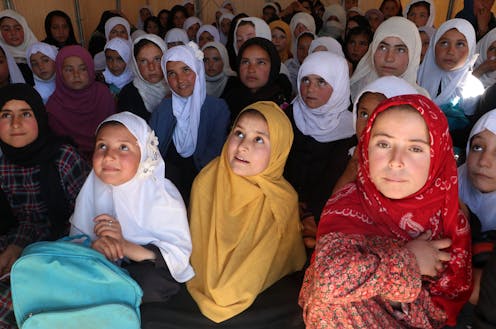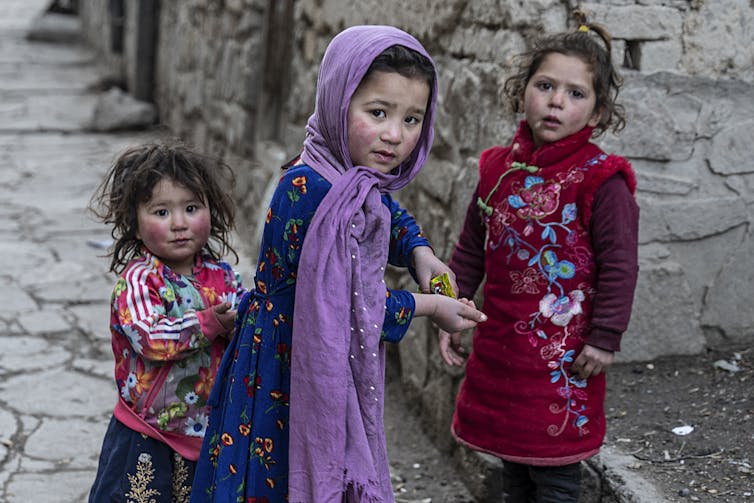I spent a decade helping Afghan girls make educational progress − and now the Taliban are using thes
If the ban on girls’ education in Afghanistan persists, consequences could include higher rates of abuse, the spread of extremism and billions of dollars in economic loss.

Before the collapse of the Afghan government in August 2021, girls’ access to education was steadily improving.
In 2019, the Ministry of Education introduced the country’s first Girls Education Policy, known as the GEP. This policy sought to improve women’s literacy rates and access to education nationwide. The National Education Strategic Plan and the Girls’ Education Strategy were working to increase gender equity as well, through initiatives such as hiring 30,000 additional female teachers.
For a decade, I was part of these efforts advocating for change.
This all came to a halt when the Taliban took over and immediately outlawed education for girls after the sixth grade. Afghanistan is now the only country in the world that restricts girls’ education by law.
Should this ban persist, the consequences would be dire. Millions of girls will face increased abuse and trauma. Families may be forced to leave the country. Additionally, the ban may intensify extremism and lead to billions of dollars in economic losses.
A history of progress in girls’ education
This is the second time that the Taliban have banned education for girls in Afghanistan. The first time was during their previous regime in the late 1990s. When the Taliban were overthrown in 2001, everything changed. Communities, civil society, the Afghanistan government and international partners, including foreign governments and NGOs, came together to support girls’ education. Consequently, school enrollments for girls increased dramatically from almost none in 2001 to about 4 million by 2020.
Even with these efforts, there were still significant disparities. In 2019, about 3.7 million children in Afghanistan were out of school, and 60% were girls. Out of the roughly 9.2 million children in school, girls accounted for only 38%, even though they make up about half of the population.
Before the Taliban’s return to power, the government continued to show a solid commitment to advancing girls’ education. This included plans to hire new teachers, construct new schools, upgrade learning facilities and increase awareness and social support for the cause.
The Taliban takeover
The landscape of girls’ education, however, underwent a drastic setback following the collapse of the government in 2021. Within a month of taking power, the Taliban banned girls from secondary schools and rescinded educational policies, including the GEP, through more than a dozen orders.
These changes came as a shock to many Afghans. During peace talks in Qatar in 2019 and 2020, the Taliban’s chief negotiators promised to uphold women’s rights, including the rights to education and work.
Protests against the education ban quickly spread across the nation, reflecting global anger. Western nations strongly urged the Taliban to revoke the ban, a sentiment echoed by many Muslim-majority countries, too. The United Nations issued urgent calls for the Taliban to respect and uphold the educational rights of Afghan girls. International human rights organizations, such as Amnesty International and Human Rights Watch, have documented the harmful effects of the ban.
Nobel laureate Malala Yousafzai described the ban as part of a broader gender apartheid in Afghanistan and demanded an immediate end to it. Initiatives such as #LetAfghanGirlsLearn have been launched to garner support for this cause.
According to a report from the Institute for the Study of War, there is even some opposition to the ban within the Taliban ranks. Some have publicly criticized the decision and sent their own daughters to school secretly.
The ban’s impact has been catastrophic. Officially, at least 1 million girls have been banned from schools. Unofficially, the number could be twice as high, and it will increase annually as girls graduate from primary school. The ban hit close to home for me as well. My sister was barred from school in her final year – three months before graduation.
No easy path forward
What are the chances of the Taliban reversing their ban on girls’ education? To answer this question, it’s crucial to understand why the Taliban have implemented this drastic policy and the potential implications if they continue to adhere to it.
Initially, the Taliban argued that girls’ secondary schools conflicted with patriarchal religious and cultural values that dictate what types of schooling girls can receive and what role they should have in society. Some supporters of the Taliban drew parallels with Iran’s restrictions on female education after its revolution, citing the need to “purify” the educational environment and urging patience for the reopening of girls’ schools.
This argument contradicts the reality on the ground. Girls’ education has received widespread support from Afghans over the past two decades, with millions of families endorsing it. Additionally, many within the religious community have voiced their support for girls’ schools, asserting that both boys and girls are entitled to receive an education. Afghans from all walks of life continue to protest for the reopening of schools.
In a second argument justifying the ban, Taliban leaders have claimed to be open to negotiation on critical issues such as girls’ education in exchange for international recognition of their regime. This argument, rooted in political strategy, suggests that the Taliban see girls’ education as a bargaining chip – a tool to achieve their political objectives. In essence, they are holding the right to education hostage.

The Taliban’s third justification stems from fear. The ultraconservative Taliban leaders who control the policy on education believe that educated girls won’t abide by their ideology. They consider girls’ education to be the foundation of broader social change that would challenge their power.
Even if the Taliban were to allow girls to return to school at some point, it would not be to the same educational environment they left behind. Instead, it would likely be a system engineered along ideological lines, far from inclusive and sustainable.
If trends continue, the consequences are clear. A whole generation of uneducated women are more likely to face marginalization, abuse and violence. Banning girls’ education stifles the potential of half the population and hinders social and economic progress. If this persists, Afghanistan will stay in deep poverty and face enduring global isolation, worsening the country’s existing challenges. Banning girls from schools poses a threat that goes far beyond Afghanistan’s borders.
Enayat Nasir, a Fulbright scholar, is a co-founder and distinguished member of various initiatives advocating for the education of Afghan girls.
Read These Next
From record warming to rusting rivers, 2025 Arctic Report Card shows a region transforming faster th
The 20th anniversary of the annual report tracks how sea ice, snow cover and many other vital signs…
2 superpowers, 1 playbook: Why Chinese and US bureaucrats think and act alike
The men and women tasked with implementing policy are governed by the same incentives and constraints…
A, B, C or D – grades might not say all that much about what students are actually learning
Grades can magnify inequities that exist in American schools, making it harder for some students to…






